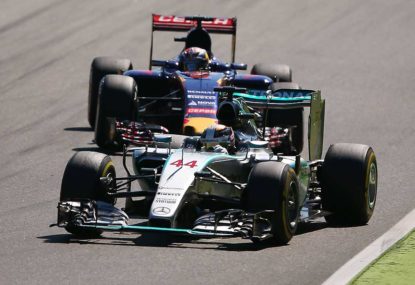Roar Guru

With more than a sizeable section of the Formula One pie-graph in (or having been) teetering with insolvency in some form or other over the last 36 months, it’s fair to say that pesos or rupiah is going to have leverage in who slips their derriere into a cockpit these days.
Nonetheless, even in our cynical age, there has been the odd moan over Rio Haryanto’s promotion to a Manor race seat (alongside current DTM champ Pascal Wehrlein) over Alexander Rossi and Will Stevens. The argument going that potential points acquired via a Rossi-Werhlein pairing would outweigh that raised by the Indonesian government.
The Haryanto deal hasn’t been the work of a moment, with manager Piers Hunniset (Eurasia Motorsport co-founder and the man responsible for placing Narain Karthikeyan at Jordan) spending the last 12 months securing deals with Indonesian investors and dignitaries to ensure the Republic has its first Formula One star.
Firstly, let’s give Manor a little credit, for Haryanto is no Alex Yoong and is no stranger to Manor having competed with the team’s GP3 outfit in 2010 alongside Adrien Tambay (son of Patrick) and Adrian Quaiffe-Hobbs. Rio finished the season as the leading Manor driver, but inconsistency the following year say him drop out of the championship hunt. It’s worth noting however, that Haryanto’s two wins came in the wet. This is the true benchmark of talent, which was backed up with pole position and fastest lap in the 2012 GP2 race at Spa.
But it wasn’t until the GP2 sprint race in Austria this year that Rio’s potential as a more rounded driver began to emerge. With and overcast conditions that left engineers scratching their heads, Haryanto was able to soak up pressure from pole-sitter Artem Markelov, despite not having similar pace and being vulnerable to numerous DRS attacking opportunities.
Knowing it was only a matter of time before Markelov’s composure ran its course, the Russian made the inevitable dive down the inside, biting off more than he could masticate by slicing off crucial elements of Haryanto’s front wing.
Haryanto held the lead as Markelov fell to eighth, but now had to contend with McLaren wunderkind and championship leader Stoffel Vandoorne, who was now up to second place and looking for cracks in Haryanto’s defence. Knowing he had Vandoorne covered in the run through Remus (turn 2), there was little the Belgian could do in finding a way past. Unshaken by the altercation with Markelov, Haryanto executed the Brabham/Stewart/Prost stratagem of winning at the slowest possible speed by pushing Vandoorne back into the clutches of teammate Nobuharu Matsushita and Sergey Sirotkin to record his second victory of the season.
Wet weather prowess, car management and race-craft are not ingredients you usually associate with ‘pay drivers’, but why has it taken Haryanto so long you might argue? Well if you’re making (unfair) comparisons with Max Verstappen, then yes, he’s a bit of a Mark Twain. But if you acknowledge that Lewis Hamilton endured multiple crashes in his junior career – that would’ve ended those of his less financed contemporaries – there’s a case to be made that the still young Indonesian deserves a shot.
In 2008, Giorgio Pantano lost Formula One race seats to Bruno Senna and Vitaly Pretov despite taking the GP2 championship (and in the process becoming the most successful GP2 driver of all time) given he was well into his thirties by the time he hit his straps.
Haryanto however, is still only 23 and has ample time to hone his burgeoning talent. Remember Kamui Kobayashi? The spectacular Japanese driver may have won two rounds on route to the GP2 Asia crown, but couldn’t repeat that success in the main series.
Those that consigned him to the scrap heap were needless to say a little stunned when Kamui held off Formula One Champion-elect Jenson Button on debut at Brazil 2009 and recorded a podium finish for Sauber on home turf at Suzuka in 2012
With John McQuilliam and forer Toro Rosso designer Luca Furbatto guiding development of Manor’s 2016 challenger, there’s no reason a good baseline won’t provide Haryanto with the confidence he needs to build on the foundations he displayed last year.
A Mercedes powertrain will do his chances no harm either and make no mistake, without Werhlein on the other side of the garage, there would be no Mercedes powertrain – and vice versa – regardless of talent.
If Haryanto can shadow the much rated Werhlein, his stock will float and hopefully open the door to a raft of talented youngsters in the South-East Asian region such as Sean Gelael and Akash Neil Nandy.
Euro-centric media might bemoan the loss of another Brit on the grid, but greater progress is often overlooked in the fever of hyper-patriotism.